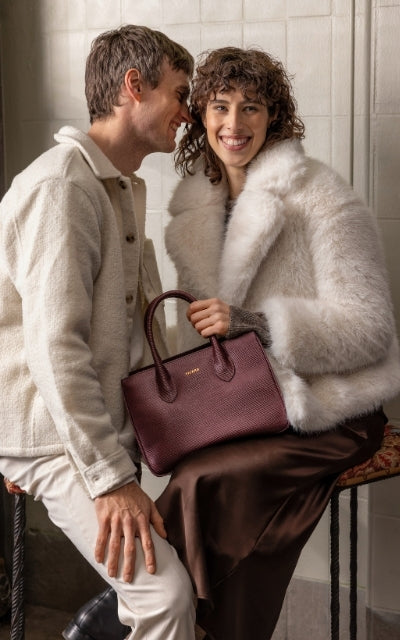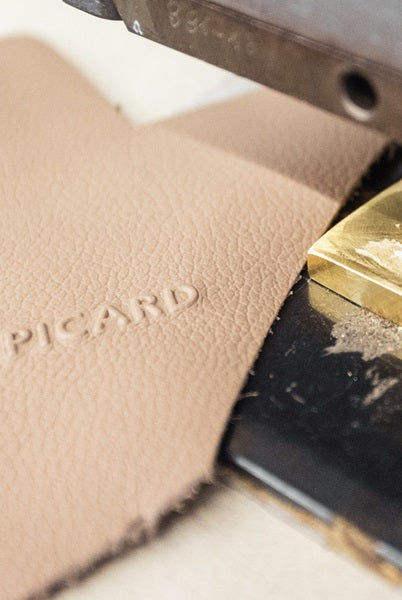Your new favorite handbag is made of suede, but what exactly is it? What are the differences between suede and smooth leather? How can I protect and care for suede? Is suede real leather?
We would like to answer these questions for you in this article so that you not only have a favorite bag, but also important information about your suede.
What is suede?
Suede is the counterpart to smooth leather. As the name suggests, the leather is roughened. Don't be alarmed, the leather doesn't feel rough at all, it has a wonderfully soft feel.
The term suede covers various types of leather , such as
- Nubuck leather ,
- Suede
- and the suede.
We will go into the details in more detail shortly.
Suede
Suede is often confused with nubuck leather or suede , but suede is a high-quality full-grain leather that comes from wild animals.
As a rule, the animals used to produce leather do not live in the wild, but are kept in enclosures.
Suede is usually made from
- Deer-,
- Kangaroo-,
- Wild boar-,
- Deer
- or antelope skin .
But there is also suede from wild animals, which is rare and therefore more expensive.
Expert knowledge: Suede is very soft and feels velvety, this is achieved by the chrome tanning with which the leather is usually tanned.
Suede
Suede is soft and supple like nubuck and suede, and is usually made from cowhide or deerskin. It is a split leather that does not have a grain side.
Unlike nubuck leather, suede is made from the flesh split .
The inside of the leather is also sanded to create a smooth surface. When making suede, the leather is roughened and thus gets its velvety feel.
The suede leather is an open-pored leather and therefore very breathable . In addition, the suede leather is not rigid, it is a "flowing leather" and for this reason is still popular today for
- Sofas,
- Shoes
- and also gloves.
Suede is a little more susceptible to dirt, dust and moisture , so you should waterproof it regularly , but small scratches in the leather can be easily removed with a suede brush.
All in all, suede is a truly trendy material, which we also like to use for our sophisticated pouch bags .
Nubuck leather
As you now know, suede is a split leather (flesh split) which is sanded on both sides. The grain side, i.e. the side that is on the outside, is used to make nubuck leather.
Just like its rough leather colleagues, suede and velour leather, the leather hide is sanded, but only from the outside, i.e. the grain side.
For the production mostly cow or calf skins are used. It is
- soft,
- breathable
- and more durable than other types of suede.
Expert knowledge: If the nubuck leather is well impregnated, it is also very water-repellent. Nubuck is often used in hiking and climbing , but also for leather handbags and accessories.
Why is suede so popular?
Suede is a very popular material in leather processing because it combines many advantages and gives the wearer a velvety warm, soft feeling.
As you know, it is very breathable and durable . Even small scratches and nicks can be made invisible with a suede brush.
If it is also well impregnated , it is very water-repellent . It doesn't matter that suede attracts a little more dirt and dust, because the advantages outweigh the disadvantages.
Suede care: What you need to consider
An important part of caring for leather is waterproofing . You should generally waterproof all your leather goods regularly. This is especially true after purchase or after cleaning. Waterproofing ensures that nubuck leather becomes waterproof.
To care for suede, you can use special care products or simple household remedies . In any case, you will need a suede brush for care and cleaning .
You can use the brush to roughen up the suede again and regularly remove coarse dirt. It is important that you do not grease the leather, otherwise you will smooth out the suede.
Leather is generally sensitive to UV radiation and the sanding process used for nubuck and suede leather increases its sensitivity even further.
The suede can fade quickly, which is why you can dye the suede at some point. Dyeing leather is not as difficult as you might initially think. You just need special leather dye, which you can use to change or freshen up the color of your suede.
Instructions on how to apply the dye and how long it takes to dry are included in the leather dye packaging . It is important that you clean your suede of dirt and dust before dyeing. You should also make sure that you use a base, as the dye is very difficult to wash off.

How can I clean suede?
Dirt and stains are unsightly, so you'll want to get rid of them quickly if they adorn your piece of jewelry. A suede brush in the household cupboard is a great thing to have.
You can use these to remove loose dust and light dirt . A dirt eraser is also great for removing stains.
Please always be careful not to rub stains into the leather , so do not apply too much pressure and do not make the stains bigger.
Of course, you can use home remedies, but we would recommend cleaning with a professional leather cleaner that is specially designed for your leather. You can then apply a waterproofing agent, which will both care for and protect your suede.
If your leather gets wet, please let it dry slowly and do not place it on the heater or in the sun to dry.
Conclusion
Suede is a fascinating material because it has many advantages and is also very pleasant to the touch and look of. It is a versatile leather that was one of the trendiest leathers in the past and is still today.
FAQ
Is suede waterproof?
No, suede is not waterproof, and if it is not waterproofed, it is actually a little susceptible to moisture. That is why regular waterproofing is a must to ensure that your leather lasts for a long time.
Is suede more robust than smooth leather?
No, suede is not as robust as smooth leather, which is also due to the roughened surface. This reduces the surface density, so it is not as robust as smooth leather .
Find out more by reading our other articles:








